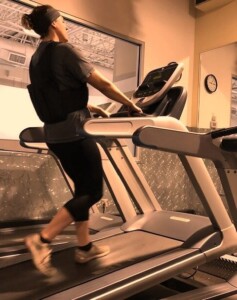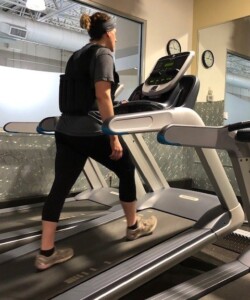
If you’re part of the hold-on-for-dear-life high treadmill incline camp, find out why you’re wasting your time, big-time.
Holding on at a high incline is so very wrong, on so many levels, I don’t even know where to begin.
Let’s begin this way: Next time you’re at the gym, look at people from the side as they walk a high incline and hold onto their treadmill. Do you notice anything peculiar?
If not, close your eyes and imagine viewing someone from the side, walking up a hill.

Source: Freepik.com, tirachard
Now compare that person’s profile to the treadmill user’s profile. Do you notice anything strange?
The outdoor hill walker’s body is vertical, forming a much less-than 90-degree angle with the hill in front of her.
Look again at the very top image of the woman holding onto an inclined treadmill.
The walker’s body is 15 degrees tilted back — 15 degrees because she’s using a 15 percent incline and leaning all the way back with it.
Her body is tilted back at the same angle as the incline because her hands are gripping the bar, arms straight.
She’s essentially walking on a flat surface because she’s reproducing the same angular relationship to the walking surface as someone who’s walking on a flat tread. This is a pseudo-incline walk.
To simulate an uphill walk, remove your hands, which will force your body to be vertical, reducing the angle between your body and the tread before you.

This will require increased hip, knee and ankle flexion, which is why uphill walking is more taxing than flat movement.
Can’t sustain this? Solution: REDUCE THE SPEED.
If you keep yourself pulled forward with bent arms, this is still cheating because your hands, arms and shoulders are keeping your body vertical, rather than any power from your lower body.
This absolutely is NOT the same as walking hands free. It does NOT “all even out.”
Now if you hold onto the side of the treadmill at a high incline, your body won’t lean back so much. However, the rails are still supporting you.
When I was a personal trainer I’d periodically get a client who was used to walking a high incline at 3.5, even 4 mph, and of course, clinging onto the front or side of the machine.
The metrics — high incline and fast waking speed — made them think they were in great shape.
However, I’d get them on a treadmill and set the speed at only 2 mph, then raise the incline to 15 percent.
Initially they’d think that 2 mph was way too slow, even though I’d instruct them to keep their hands off the treadmill. They’d look at me like, “What? This is way too easy, TWO miles an hour!”
And at first, 2 mph even hands free at the highest incline will seem like very easy work.
But quite predictably, these clients began visibly struggling and breathing heavily within several minutes.
Pretending that it was as easy as they’d first thought became increasingly difficult.
Within several minutes they’d grab the machine, panting, unable to walk any more at 2 mph without holding on.
I’d point out that 2 mph OR SLOWER is about the same speed they’d walk on an actual outdoor hill; it’s not slow at all when it’s done on a high incline!
If you’ve been holding onto a treadmill at high inclines and setting the speed at 4 mph, try this experiment: Set it at 2 mph at 15 percent.
Without any holding on whatsoever, see how long you can sustain this. Don’t be surprised if very soon, your calves begin burning and/or your lower back begins aching.
That’s because when you hold on, the calves and core do VERY LITTLE work. Because they’re not used to the workload of hands-free incline walking, they quickly burn and ache when you finally do let go.
Holding onto the treadmill also promotes an unnatural gait and burns far fewer calories than what the console displays.
Solution: Use the incline, hands OFF, at 1 to 2 mph, for short periods, alternating with hands-free walking on a flat setting.
Over the next several weeks (depending on how often you follow these instructions) those dormant muscles will become more efficient and no longer ache or burn. You’ll also notice an improvement in aerobic ability.
 Lorra Garrick is a former personal trainer certified through the American Council on Exercise. At Bally Total Fitness she trained women and men of all ages for fat loss, muscle building, fitness and improved health.
Lorra Garrick is a former personal trainer certified through the American Council on Exercise. At Bally Total Fitness she trained women and men of all ages for fat loss, muscle building, fitness and improved health.
Top image: ©Lorra Garrick











